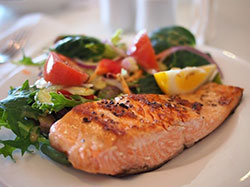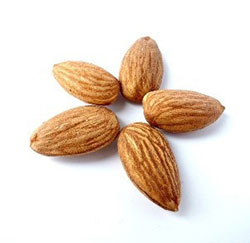Vitamins That Can Cause Toxicity if Ingested in Excessive Amounts Are: Quizlet
Print this fact sheet
by J. Clifford and A. Kozil* (9/17)
Quick Facts…
- Small amounts of vitamin A, vitamin D, vitamin Eastward and vitamin K are needed to maintain good health.
- Fat-soluble vitamins volition not be lost when the foods that incorporate them are cooked.
- The body does not need these vitamins every day and stores them in the liver and adipose (fat) tissue when not used.
- Most people do not need vitamin supplements.
- Megadoses of vitamins A, D, Eastward or K tin exist toxic and atomic number 82 to health bug.
- Requirements for vitamins may be expressed in different mathematical units. Close attending should be paid to ensure that similar units are being compared.
What are Vitamins?
Vitamins are essential micronutrients required by the body in small amounts to support a range of vital functions. Vitamins are divided into two groups: h2o-soluble (B-circuitous vitamins and C
vitamins) and fat-soluble vitamins (A, D, E and K). Unlike water-soluble vitamins that need regular replacement in the body, fatty-soluble vitamins are stored in the liver and fatty tissues, and are
eliminated much more slowly than water-soluble vitamins. For more data on water-soluble vitamins, see fact sheet ix.312 Water-Soluble Vitamins: Vitamin B-Circuitous and Vitamin C.
What are Fat-Soluble Vitamins?
The fat-soluble vitamins, A, D, Due east, and K, are stored in the body for long periods of time and generally pose a greater risk for toxicity than water-soluble vitamins when consumed in excess. Eating a normal, well-balanced diet will not lead to toxicity in otherwise salubrious individuals. However, taking vitamin supplements that contain megadoses of vitamins A, D, Eastward and K may pb to toxicity.
While diseases caused by a lack of fat-soluble vitamins are rare in the United States, symptoms of mild deficiency tin develop without adequate amounts of vitamins in the nutrition. Additionally, some
health problems, such equally inflammatory bowel disease (IBD), chronic pancreatitis, and cystic fibrosis, may decrease the absorption of fat, and in plow, decrease the absorption of vitamins A, D, E and K. Consult a medical professional almost any potential wellness problems that may interfere with vitamin assimilation.
Vitamin A: Retinol

What is Vitamin A?
Vitamin A, likewise called retinol, has many functions in the body. In addition to helping the eyes adapt to light changes, vitamin A plays an of import part in bone growth, tooth development, reproduction, jail cell division, gene expression, and regulation of the allowed organisation. The peel, eyes, and mucous membranes of the oral cavity, nose, throat and lungs depend on vitamin A to remain moist. Vitamin A is also an important antioxidant that may play a part in the prevention of certain cancers.
Food Sources for Vitamin A
Eating a broad variety of foods is the best manner to ensure that the body gets enough vitamin A. The retinol, retinal, and retinoic acid forms of vitamin A are supplied primarily by foods of fauna origin such equally dairy products, fish and liver. Some foods of found origin contain the antioxidant, beta-carotene, which the body converts to vitamin A. Beta-carotene, comes from fruits and vegetables, especially those that are orange or dark green in color. Vitamin A sources too include carrots, pumpkin, winter squash, dark greenish leafy vegetables and apricots, all of which are rich in betacarotene.
How Much Vitamin A Do We Need?
The recommendation for vitamin A intake is expressed as micrograms (mcg) of retinol activity equivalents (RAE). Retinol activity equivalents account for the fact that the body converts but a portion of beta-carotene to retinol. One RAE equals 1 mcg of retinol or 12 mcg of beta-carotene (Table 1). The Recommended Dietary Allowance (RDA) for vitamin A is 900 mcg/ day for adult males and 700 mcg/solar day for adult females.
Compared to vitamin A containing foods, it takes twice the amount of carotene rich foods to see the body's vitamin A requirements, and then ane may need to increase consumption of carotene containing plant foods to encounter the RDA for vitamin A.
Studies betoken that vitamin A requirements may exist increased due to hyperthyroidism, fever, infection, cold, and exposure to excessive amounts of sunlight. Those who consume backlog alcohol or have renal disease should likewise increase intake of vitamin A.
Vitamin A Deficiency
Vitamin A deficiency in the United States is rare, but the disease that results is known equally xerophthalmia, which can atomic number 82 to blindness if untreated. Information technology most commonly occurs in developing nations usually due to malnutrition. Since vitamin A is stored in the liver, it may take upwards to 2 years for signs of deficiency to announced. Night blindness and very dry, rough peel may indicate a lack of vitamin A. Other signs of possible vitamin A deficiency include decreased resistance to infections, faulty molar development, and slower bone growth. Vitamin A deficiency is besides a known risk factor for severe measles. According to the World Health Organisation (WHO), Vitamin A supplementation tin significantly reduce mortality rates for children with measles who alive in areas with a high prevalence of Vitamin A deficiency. The effectiveness of vitamin A supplementation to treat measles in countries, such as the United States, where vitamin A intakes are generally adequate, is uncertain.
Too much Vitamin A
In the United States, toxic or excess levels of vitamin A are more of a business concern than deficiencies. The Tolerable Upper Intake Level (UL) for adults is 3,000 mcg RAE (Table ii). Information technology would be difficult to reach this level consuming food lonely, but some multivitamin supplements incorporate loftier doses of vitamin A. Retinol is the form of vitamin A that causes the greatest concern for toxicity. If y'all take a multivitamin, bank check the label to exist sure the bulk of vitamin A provided is in the form of beta-carotene, which appears to exist safety. Some medications used to treat acne, psoriasis, and other peel weather contain compounds that mimic retinol in the body. Much like excessive intake of dietary retinol, these medications have been shown to negatively affect bone health and upshot in delayed growth in children and teens.
Symptoms of vitamin A toxicity include dry out, itchy skin, headache, nausea, and loss of ambition. Signs of astringent overuse over a short period of time include dizziness, blurred vision and slowed growth. Vitamin A toxicity tin besides cause severe nascency defects and may increase the hazard for bone loss and hip fractures.
Vitamin D

What is Vitamin D?
Vitamin D plays a critical office in the torso'south use of calcium and phosphorous. It works by increasing the amount of calcium captivated from the minor intestine, helping to form and maintain bones. Vitamin D benefits the trunk by playing a function in amnesty and controlling cell growth and may protect against osteoporosis, high blood force per unit area, cancer, and other diseases. Children particularly need adequate amounts of vitamin D to develop strong bones and healthy teeth.
Food Sources for Vitamin D
The primary food sources of vitamin D are milk and other dairy products fortified with vitamin D. Vitamin D is also found in oily fish (e.g., herring, salmon and sardines) too as in cod liver oil. In addition to the vitamin D provided by food, we obtain vitamin D through our skin which produces vitamin D in response to sunlight.
How much Vitamin D Do Nosotros Need?
The Recommended Dietary Allowance (RDA) for vitamin D appears every bit micrograms (mcg) of cholecalciferol (vitamin D3) (Table 1). From 12 months to age fifty, the RDA is gear up at 15 mcg. Twenty mcg of cholecalciferol equals 800 International Units (IU), which is the recommendation for maintenance of salubrious os for adults over fifty. Table 1 lists additional recommendations for diverse life stages.
Exposure to ultraviolet light is necessary for the trunk to produce the active form of vitamin D. Ten to xv minutes of sunlight without sunscreen on the hands, artillery and face, twice a week is sufficient to receive enough vitamin D. This can easily exist obtained in the time spent riding a bicycle to work or taking a brusque walk with arms and legs exposed. In order to reduce the adventure for skin cancer 1 should apply sunscreen with an SPF of 15 or more, if fourth dimension in the sun exceeds 10 to fifteen minutes.
Vitamin D Deficiency
Symptoms of vitamin D deficiency in growing children include rickets (long, soft bowed legs) and flattening of the back of the skull. Vitamin D deficiency in adults may result in osteomalacia (musculus and bone weakness), and osteoporosis (loss of os mass). Vitamin D deficiency has been associated with increased risk of common cancers, autoimmune diseases, hypertension, and infectious disease.Inquiry shows that vitamin D insufficiency affects well-nigh 50% of the population worldwide; an estimated 1 billion people. The rising rate of deficiency has been linked to a reduction in outdoor activity and an increment in the employ of sunscreen amongst children and adults. In improver, those who live in inner cities, wear clothing that covers near of the pare, or live in northern climates where little sun is seen in the wintertime are also prone to vitamin D deficiency. Since almost foods have very low vitamin D levels (unless they are enriched) a deficiency may be more than likely to develop without adequate exposure to sunlight. Adding fortified foods to the diet such as milk, and for adults including a supplement, are effective at ensuring acceptable vitamin D intake and preventing depression vitamin D levels. In the absence of acceptable sun exposure, at least 800 to 1,000 IU of vitamin D3 may be needed to reach the circulating level required to maximize vitamin D's benefits.
Who is at Adventure — These populations may crave extra vitamin D in the form of supplements or fortified foods:
- Exclusively breast-fed infants : Homo milk only provides 25 IU of vitamin D per liter. All breast-fed and partially breast-fed infants should exist given a vitamin D supplement of 400 IU/day.
- Dark Pare : Those with dark pigmented skin synthesize less vitamin D upon exposure to sunlight compared to those with light pigmented peel.
- Elderly : This population has a reduced power to synthesize vitamin D upon exposure to sunlight, and is besides more likely to stay indoors and wear sunscreen which blocks vitamin D synthesis.
- Covered and protected skin : Those that embrace all of their skin with habiliment while outside, and those that wear sunscreen with an SPF cistron of 8, block most of the synthesis of vitamin D from sunlight.
- Disease : Fat malabsorption syndromes, inflammatory bowel affliction (IBD), and obesity are all known to outcome in a decreased power to blot and/or use vitamin D in fatty stores.
As well much Vitamin D

The Tolerable Upper Intake Level (UL) for vitamin D is set at 100 mcg (4000 IUs) for people 9 years of age and older (Tabular array ii). High doses of vitamin D supplements coupled with large amounts of fortified foods may cause accumulations in the liver and produce signs of poisoning. Signs of vitamin D toxicity include backlog calcium in the blood, slowed mental and concrete growth, decreased appetite, nausea and airsickness.
It is especially important that infants and immature children do non consume excess amounts of vitamin D regularly, due to their pocket-sized body size.
Vitamin Due east: Tocopherol
What is Vitamin E?
Vitamin E benefits the body by acting as an antioxidant, and protecting vitamins A and C, scarlet blood cells, and essential fatty acids from destruction. Inquiry from decades ago suggested that taking antioxidant supplements, vitamin Due east in detail, might help forestall heart illness and cancer. Still, newer findings signal that people who take antioxidant and vitamin E supplements are not ameliorate protected against heart disease and cancer than not-supplement users. Many studies show a link between regularly eating an antioxidant rich diet total of fruits and vegetables, and a lower risk for centre disease, cancer, Alzheimer'southward Illness, and several other diseases. Essentially, inquiry indicates that to receive the full benefits of antioxidants and phytonutrients in the diet, one should consume these compounds in the form of fruits, vegetables, basics, and seeds, not as supplements.
Food Sources for Vitamin E
About 60 pct of vitamin Eastward in the nutrition comes from vegetable oil (soybean, corn, cottonseed, and safflower). This also includes products fabricated with vegetable oil (margarine and salad dressing). Vitamin E sources also include fruits and vegetables, grains, nuts (almonds and hazelnuts), seeds (sunflower) and fortified cereals.
How much Vitamin E Do We Need?
The Recommended Dietary Assart (RDA) for vitamin E is based on the most active and usable form called blastoff-tocopherol (Table 1). Food and supplement labels list alpha-tocopherol as the unit international units (IU) or micrograms (mcg), not in milligrams (mg). One microgram of alpha-tocopherol equals to 1.5 International units (IU). RDA guidelines state that males and females over the age of 14 should receive 15 mcg (22.v IUs) of alpha-tocopherol per day. Consuming vitamin Eastward in excess of the RDA does not issue in any added benefits.
Vitamin E Deficiency
Vitamin E deficiency is rare. Cases of vitamin Due east deficiency usually only occur in premature infants and in those unable to absorb fats. Since vegetable oils are expert sources of vitamin Eastward, people who excessively reduce their total dietary fat may not get enough vitamin E.
Besides much Vitamin E
The Tolerable Upper Intake Level (UL) for vitamin Due east is shown in Tabular array 2.Vitamin E obtained from food ordinarily does not pose a chance for toxicity. Supplemental vitamin Eastward is non recommended due to lack of evidence supporting any added health benefits. Megadoses of supplemental vitamin E may pose a adventure to people taking blood-thinning medications such equally Coumadin (too known equally warfarin) and those on statin drugs.
Vitamin K
What is Vitamin K?
Vitamin 1000 is naturally produced by the bacteria in the intestines, and plays an essential role in normal blood clotting, promoting bone health, and helping to produce proteins for blood, basic, and kidneys.
Nutrient Sources for Vitamin Thou
Skillful food sources of vitamin One thousand are green, leafy-vegetables such every bit turnip greens, spinach, cauliflower, cabbage and broccoli, and certain vegetables oils including soybean oil, cottonseed oil, canola oil and olive oil. Animal foods, in general, contain limited amounts of vitamin K.
How much Vitamin 1000 Do We Demand?
To assistance ensure people receive sufficient amounts of vitamin K, an Acceptable Intake (AI) has been established for each historic period group (Table 1).
Vitamin K Deficiency

Without sufficient amounts of vitamin Yard, hemorrhaging can occur. Vitamin Thousand deficiency may appear in infants or in people who take anticoagulants, such as Coumadin (warfarin), or antibiotic drugs. Newborn babies lack the abdominal bacteria to produce vitamin K and need a supplement for the outset calendar week. Those on anticoagulant drugs (blood thinners) may become vitamin Chiliad deficient, but should not alter their vitamin Thou intake without consulting a physician. People taking antibiotics may lack vitamin K temporarily because intestinal bacteria are sometimes killed every bit a result of long-term utilize of antibiotics. Also, people with chronic diarrhea may have bug absorbing sufficient amounts of vitamin K through the intestine and should consult their md to determine if supplementation is necessary.
Too much Vitamin Yard
Although no Tolerable Upper Intake Level (UL) has been established for vitamin Yard, excessive amounts can crusade the breakdown of red blood cells and liver damage. People taking blood-thinning drugs or anticoagulants should moderate their intake of foods with vitamin 1000, considering excess vitamin K tin can change claret clotting times. Large doses of vitamin Chiliad are not advised.
Summary
- Fatty-soluble vitamins: A, D, Eastward, and One thousand —are stored in the body for long periods of time, and pose a greater gamble for toxicity than water-soluble vitamins. Fat-soluble vitamins are only needed in minor amounts.
- Beta carotene is an important antioxidant that the trunk converts to Vitamin A,and it is constitute in a variety of fruits and vegetables.
- Inadequate dietary consumption of vitamin D, along with limited sun exposure, makes vitamin D deficiency a growing public health concern.
- Vitamin E benefits the trunk by acting as an antioxidant, and research indicates that it may offer a protective event if obtained through a diet rich in fruits and vegetables, equally opposed to a supplement or multivitamin.
- The bacteria in our gut produce vitamin K, and it is as well constitute in green leafy vegetables.
Table 1. Recommended Dietary Intake (RDA) and Adequate Intake (AI) for Fat-Soluble Vitamins
| Life Stage Group | Vitamin A (mcgane/RAE) | Vitamin D (mcgii) | Vitamin E (mcg a-TEiii) | Vitamin K (mcg) | |||||||||||||||||||||||||||||||||||||||||||||
| Infantsfour | |||||||||||||||||||||||||||||||||||||||||||||||||
| 0 – 6mo | 400* | 10* | 4* | 2.0* | |||||||||||||||||||||||||||||||||||||||||||||
| 6mo – 12mo | 500* | ten* | five* | 2.5* | |||||||||||||||||||||||||||||||||||||||||||||
| Children | |||||||||||||||||||||||||||||||||||||||||||||||||
| ane – 3y | 300 | 15 | 6 | 30* | |||||||||||||||||||||||||||||||||||||||||||||
| 4 – 8y | 400 | xv | seven | 55* | |||||||||||||||||||||||||||||||||||||||||||||
| Males | |||||||||||||||||||||||||||||||||||||||||||||||||
| 9 – 13y | 600 | 15 | 11 | sixty* | |||||||||||||||||||||||||||||||||||||||||||||
| 14 – 18y | 900 | fifteen | 15 | 75* | |||||||||||||||||||||||||||||||||||||||||||||
| 19 – 30y | 900 | xv | 15 | 120* | |||||||||||||||||||||||||||||||||||||||||||||
| 31 – 50y | 900 | 15 | 15 | 120* | |||||||||||||||||||||||||||||||||||||||||||||
| 51 – 70y | 900 | 15 | 15 | 120* | |||||||||||||||||||||||||||||||||||||||||||||
| >70y | 900 | 20 | 15 | 120* | |||||||||||||||||||||||||||||||||||||||||||||
| Females | |||||||||||||||||||||||||||||||||||||||||||||||||
| 9 – 13y | 600 | fifteen | xi | lx* | |||||||||||||||||||||||||||||||||||||||||||||
| 14 – 18y | 700 | xv | 15 | 75* | |||||||||||||||||||||||||||||||||||||||||||||
| 19 – 30y | 700 | 15 | 15 | 90* | |||||||||||||||||||||||||||||||||||||||||||||
| 31 – 50y | 700 | 15 | 15 | 90* | |||||||||||||||||||||||||||||||||||||||||||||
| 51 – 70y | 700 | xv | 15 | 90* | |||||||||||||||||||||||||||||||||||||||||||||
| >70y | 700 | xx | fifteen | xc* | |||||||||||||||||||||||||||||||||||||||||||||
| Pregnant | |||||||||||||||||||||||||||||||||||||||||||||||||
| 14 – 18y | 750 | 15 | 15 | 75 | |||||||||||||||||||||||||||||||||||||||||||||
| 19 – 30y | 770 | 15 | 15 | 90 | |||||||||||||||||||||||||||||||||||||||||||||
| 31 – 50y | 770 | 15 | 15 | 90 | |||||||||||||||||||||||||||||||||||||||||||||
| Lactation | |||||||||||||||||||||||||||||||||||||||||||||||||
| 14 – 18y | 1200 | 15 | 19 | 75 | |||||||||||||||||||||||||||||||||||||||||||||
| 19 – 30y | 1300 | 15 | 19 | 90 | |||||||||||||||||||||||||||||||||||||||||||||
| 31 – 50y | 1300 | 15 | nineteen | 90 | |||||||||||||||||||||||||||||||||||||||||||||
oneAs retinol activeness equivalents (RAEs). 1 RAE = 1mcg retinol or 12 mcg beta-carotene.
2Equally cholecalciferol (vitamin D3). 10 mcg cholecalciferol = 400 IU of Vitamin D.
3As alpha-tocopherol equivalents. 1 mg of alpha-tocopherol = i.5 IU of Vitamin E=22IU of d-alpha-tocopherol=33 IU of dl-alpha- tocopherol
4At 6 months of historic period, infants may be introduced to solid foods while remaining on formula or breast milk. In that location may be some overlap in specific nutrient requirements.
*Indicates an Acceptable Intake (AI). All other values are Recommended Dietary Allowance (RDA).
Table 2. Tolerable Upper Intake Levels (UL) for Fat-Soluble Vitamins
| Life Stage Group | Vitamin A (mcg/d) | Vitamin D (mcg/d) | Vitamin E (mg a-TE) | Vitamin M* |
| Infantsi | ||||
| 0 – 6mo | 600 | 25 | NDtwo | ND |
| 6mo – 12mo | 600 | 38 | ND | ND |
| Children | ||||
| 1 – 3y | 600 | 63 | 200 | ND |
| 4 – 8y | 900 | 75 | 300 | ND |
| Males/Females | ||||
| 9 – 13y | 1700 | 100 | 600 | ND |
| 14 – 18y | 2800 | 100 | 800 | ND |
| 19 – 70y | 3000 | 100 | 1000 | ND |
| >70y | 3000 | 100 | 1000 | ND |
| Significant and Lactating | ||||
| <18 | 2800 | 100 | 800 | ND |
| 19 – 50y | 3000 | 100 | 1000 | ND |
iAt 6 months of historic period, infants may be introduced to solid foods while remaining on formula or breast milk. There may be some overlap in specific nutrient requirements.
twoND = not determinable due to insufficient data
*An UL for vitamin K was not established.
References
Berdanier, C., Berdanier, L., Zempleni, J. (2009). Avant-garde Nutrition: Macronutrients, Micronutrients, and Metabolism. Boca Raton, FL: CRC Press, Taylor & Francis Group.
Duyff, R. (2012). American Dietetic Association: Consummate Nutrient and Nutrition Guide. Hoboken, NJ: John Wiley & Sons, Inc.
Gropper, Due south., Smith, J. (2009).Advanced Diet and Human Metabolism. Belmont, CA: Wadsworth, Cengage Learning.
Holick, M., Chen, T. (2008). Vitamin D deficiency: a worldwide problem with health consequences. American Journal of Clinical Nutrition, 87 (4), 1080-1086.
Found of Medicine (U.s.). (2002). Dietary Reference Intakes for Vitamin A, Vitamin K, Arsenic, Boron, Chromium, Copper, Iodine, Iron, Manganese, Molybdenum, Nickel, Silicon, Vanadium, and Zinc. Washington, DC: National University Press.
Institute of Medicine (U.s.). (2000). Dietary Reference Intakes for Vitamin C, Vitamin E, Selenium, and Carotenoids. Washington, DC: National University Printing.
Institute of Medicine (The states) Committee to Review Dietary Reference Intakes for Vitamin D and Calcium; Ross A., Taylor, C., Yaktine, A., et al., editors. (2011). Dietary Reference Intakes for Calcium and Vitamin D. Washington, DC: National Academies Press. Retrieved from: https://www.ncbi.nlm.nih.gov/books/NBK56070/ doi: 10.17226/13050.
* J. Clifford, Colorado Country University Extension nutrient and nutrition specialist , A. Kozil, graduate educatee. Original fact canvass revised by L. Bellows, Colorado State University Extension food and nutrition specialist and banana professor; and R. Moore, graduate student. 11/2012 . Revised nine/17.
Go to pinnacle of this page.
Source: https://extension.colostate.edu/topic-areas/nutrition-food-safety-health/fat-soluble-vitamins-a-d-e-and-k-9-315/
0 Response to "Vitamins That Can Cause Toxicity if Ingested in Excessive Amounts Are: Quizlet"
Postar um comentário